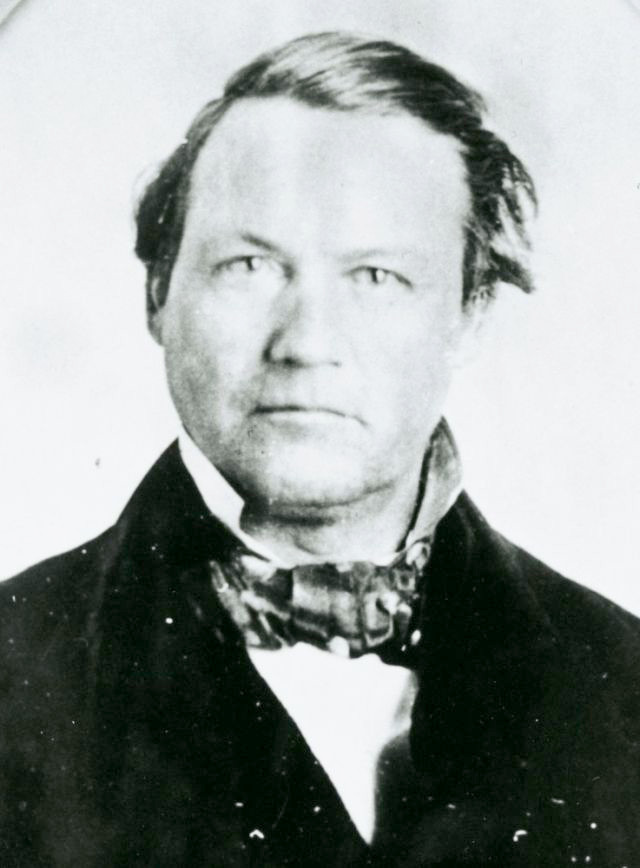Lyman Eugene Johnson
(1811-1856)


By Susan Easton Black
Nine months after Lyman entered baptismal waters, in November 1831 the Prophet Joseph Smith received a revelation directing him and the other faithful elders to be missionaries: “Go ye into all the world, preach the gospel to every creature, acting in the authority which I have given you” (D&C 68:8). Another revelation received on January 25, 1832 directed Lyman to serve a mission with Orson Pratt to the Eastern States (see D&C 75:14). Lyman, the son of rich farmer John Johnson, was reported to leave Ohio penniless and with one change of clothing, even though his journey took him from Ohio to Pennsylvania and then to New Jersey and New York.
After his missionary journey, Lyman returned to Ohio and attended the School of the Prophets before being asked to recruit volunteers for Zion’s Camp. On the camp march, Lyman spoke on “the necessity of men being upright in their walk, and keeping the Sabbath day holy.”1 At a reunion of volunteers, who had marched with Zion’s Camp, Lyman was called to be an apostle. He was the first apostle named at the February 14, 1835 reunion. Lyman did not become president of the Quorum of the Twelve Apostles because ranking in the quorum was based on seniority of age. At age 23 Lyman was the youngest member of the quorum and served in the twelfth position. In the blessing given him at the time of his call, he was told that “he should bear the tidings of salvation to nations, tongues, and people, until the utmost corners of the earth shall hear the tidings.”2 The blessing began to be fulfilled as Lyman labored along the eastern seaboard of Canada.
The apostasy of Lyman Johnson began in 1837 in Kirtland. Lyman claimed his $6,000 loss in a merchandising venture was the fault of the Prophet Joseph Smith and the Kirtland Safety Society. Lyman and Orson Pratt preferred charges against the Prophet “for lying and misrepresentation also for extortion and for speaking disrespectfully, against his brethren behind their backs.”3 The charges were dismissed. However, charges against Lyman for misrepresentation led to his being disfellowshipped on September 3, 1837. A week later, he confessed his wrongs against the Prophet Joseph and was granted full fellowship.
But something remained amiss. When Heber C. Kimball spoke with Lyman about his upcoming mission to England, Lyman said, “‘Brother Heber . . . I am sorry you are going, and consider you are foolish; but if you are determined to go I will help you all that is in my power’; and he took from his shoulders a good, nice camlet cloak and put it onto mine. . . . That cloak I wore three times across the sea, and Parley P. Pratt wore it four times; and in all it crossed the sea seven times.”4
On April 13, 1838 in Far West, Missouri (without his being present) Lyman was excommunicated from the Church for unrighteous conduct, distressing the innocent, physically assaulting Phineas Young, failing to attend Church meetings, and not complying with the Word of Wisdom. Brigham Young reported that Lyman later lamented his actions and said, “I would suffer my right hand to be cut off, if I could believe it again. Then I was full of joy and gladness. My dreams were pleasant. When I awoke in the morning my spirit was cheerful. I was happy by day and by night, full of peace and joy and thanksgiving. But now it is darkness, pain, sorrow, misery in the extreme. I have never since seen a happy moment.”5
In spite of his lamentations, Lyman never reunited with the Church. He remained in Ohio for a season before moving to Iowa and then to Wisconsin. Lyman died in a sleighing accident in 1856 near Prairie Du Chien, Wisconsin at age 45. An obituary notice detailed the tragedy: “He was in a sleigh with others, when it went through an air-hole in the ice, of the Mississippi.”6
1. Darrell K. Loosle, “Luke S. and Lyman E. Johnson-Apostles” (n p., n.d.), p. 3. Church History Library.
2. Minutes, Discourse, and Blessings, 14-15 February 1835, p. 149. Joseph Smith Papers.
3. See Chad J. Flake, “The Newell K. Whitney Collection,” BYU Studies 11 (Summer 1971), p. 327.
4. Heber C. Kimball, “Faith and Works—Submission to Authority—The Lord’s Provision for His Saints,” in Journal of Discourses, 6:65.
5. Brigham Young, “Trying to be Saints—Treasures of the Everlasting Hills—The Hill Cumorah, etc.,” Journal of Discourses, 19:41.
6. Prairie Du Chien Courier, December 22, 1859.
Additional Resources
- Biography of Lyman Eugene Johnson (josephsmithpapers.org)
